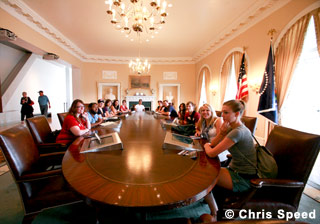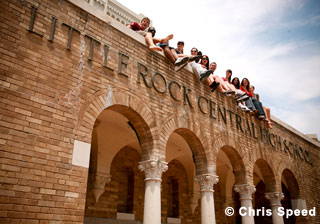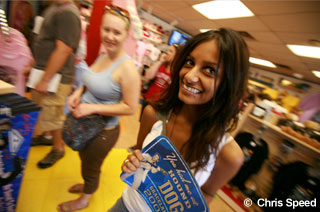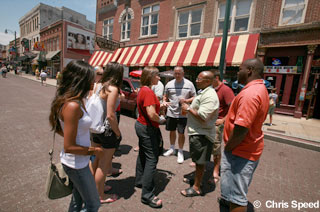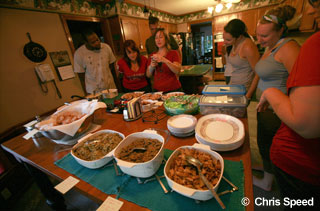 Where to begin? I’m am completely overwhelmed by trying to convey in a few short paragraphs what this day meant to me personally, and how I think it affected our group as a whole. We had no idea what to expect from our day that would be spent on a portion of the Navajo Reservation of New Mexico and Arizona. We met up with our guide for the day, Leland Silversmith, at the reservation’s visitor’s center outside Gallup, NM and across the border into Arizona. For those who may not be familiar with the Navajos, I’ll attempt to give a very brief history of the land and people based on previous research that I, as the “ambassador” for this destination, had to undertake and information we were taught while on the reservation.
Where to begin? I’m am completely overwhelmed by trying to convey in a few short paragraphs what this day meant to me personally, and how I think it affected our group as a whole. We had no idea what to expect from our day that would be spent on a portion of the Navajo Reservation of New Mexico and Arizona. We met up with our guide for the day, Leland Silversmith, at the reservation’s visitor’s center outside Gallup, NM and across the border into Arizona. For those who may not be familiar with the Navajos, I’ll attempt to give a very brief history of the land and people based on previous research that I, as the “ambassador” for this destination, had to undertake and information we were taught while on the reservation.
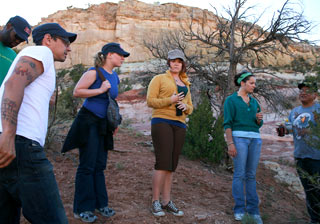 “Navajoland” encompasses an area of approximately 27,000 square miles in Utah, New Mexico and Arizona. The area lies within what the Navajo people consider to be four sacred mountains, called the “Four Corners.” The Navajos are the largest Native American tribe with a population of about 320,000, of which about 200,000 live on the actual reservation. The Navajo government is the most sophisticated American Indian government, with the same three branches as the U.S. government. The tribal government was formed in the 1920’s to facilitate the sale of rights for American companies to excavate natural resources like coal, minerals, uranium and natural gas. These resources provide money for tribal land funds, as well as jobs for the Navajo people. However, we heard while on the reservation that they were continually short-changed for the price of their coal, and had they been paid full market price for it, they may have become one of the wealthiest peoples in America. The main trade for this tribe today on the reservation is shepherding and raising cattle.
“Navajoland” encompasses an area of approximately 27,000 square miles in Utah, New Mexico and Arizona. The area lies within what the Navajo people consider to be four sacred mountains, called the “Four Corners.” The Navajos are the largest Native American tribe with a population of about 320,000, of which about 200,000 live on the actual reservation. The Navajo government is the most sophisticated American Indian government, with the same three branches as the U.S. government. The tribal government was formed in the 1920’s to facilitate the sale of rights for American companies to excavate natural resources like coal, minerals, uranium and natural gas. These resources provide money for tribal land funds, as well as jobs for the Navajo people. However, we heard while on the reservation that they were continually short-changed for the price of their coal, and had they been paid full market price for it, they may have become one of the wealthiest peoples in America. The main trade for this tribe today on the reservation is shepherding and raising cattle.
When the United States acquired the Southwest and California after defeating Mexico in 1846, the US military, led by Kit Carson, established a scorched earth policy regarding Native Americans in the area; they burned their homes and crops, killed their livestock, and basically starved those Native Americans who had not already died into submission. They forced over 8,000 Native Americans, mainly Navajos, to march approximately 300 miles from their homeland to a small camp in New Mexico called Fort Sumner and kept them there for 4 years in an internment camp. In 1868, a treaty was signed between the Navajos and the United States government that allowed the Navajos to return to a small portion of their original homeland in return for certain services like compulsory education for Navajo children and agricultural aid provided by the US government. This was just a small part of the long and troubled history of this beautiful and resilient tribe we were privileged to observe for one day.
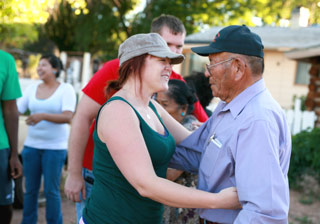 Leland Silversmith met up with us with a full itinerary prepared after having pulled a 12-hour shift at his job at the casino in Gallup, NM. He brought us to his family’s home, where his parents (who are in their 80s) graciously opened their home to us. Pastor George Silversmith, Leland’s father, told us stories both amazing and heartbreaking from his youth, from his time as a tribal police officer, from his years as a coal miner on the reservation and about his life now as shepherd, farmer and minister of their small church that’s on their property. He told us how when he was young and forced to go to boarding school, the Navajo children were beaten for speaking their native tongue, how the Caucasian boys would sometimes lie to the teacher and tell them George was speaking Navajo simply to watch him scrub the floors or have his mouth washed out with soap. He told us how when he was a tribal police officer, non-Navajos would come to the taverns at the edge of the reservation, get drunk and come over to cause trouble on the reservation and yet he had to simply stand by and let them go, because he was told repeatedly, even threatened, by state police or other sheriffs he had no jurisdiction with non-Navajos. We heard Leland’s sweet mother, Fanny, cry as she told us how much she missed her children when they were away, and most of them were, because of the lack of educational and vocational opportunities on the reservation.
Leland Silversmith met up with us with a full itinerary prepared after having pulled a 12-hour shift at his job at the casino in Gallup, NM. He brought us to his family’s home, where his parents (who are in their 80s) graciously opened their home to us. Pastor George Silversmith, Leland’s father, told us stories both amazing and heartbreaking from his youth, from his time as a tribal police officer, from his years as a coal miner on the reservation and about his life now as shepherd, farmer and minister of their small church that’s on their property. He told us how when he was young and forced to go to boarding school, the Navajo children were beaten for speaking their native tongue, how the Caucasian boys would sometimes lie to the teacher and tell them George was speaking Navajo simply to watch him scrub the floors or have his mouth washed out with soap. He told us how when he was a tribal police officer, non-Navajos would come to the taverns at the edge of the reservation, get drunk and come over to cause trouble on the reservation and yet he had to simply stand by and let them go, because he was told repeatedly, even threatened, by state police or other sheriffs he had no jurisdiction with non-Navajos. We heard Leland’s sweet mother, Fanny, cry as she told us how much she missed her children when they were away, and most of them were, because of the lack of educational and vocational opportunities on the reservation.
We simply sat in their church, a traditional hogan adjacent to their house (which their family had built with their own hands using stone and logs hauled from many miles away), and listened as this humble, kind and gracious family shared their stories with us, stories of hardships, love and overwhelming pride in their people and culture. Mrs. Silversmith’s family has been on their plot of land for generations and generations, and she speaks of her land with such love and pride it brought tears to my eyes every time she told us that this was her home and she would never leave, no matter how others might try to take their land, which is an issue the Silversmiths constantly struggle with.
Leland had his own journey to tell us about. In 2008, he walked across America, from Alcatraz to Washington D.C. along with about 100 other people fighting for the rights of Native Americans, protection of their sacred sites and the cause of environmental protection that so many Native American peoples feel so strongly about. This walk was the 30-year anniversary of a walk called “The Longest Walk” organized in 1978 as a part of the American Indian movement, which resulted in many advances in rights for Native Americans. Leland says that he participated in the walk last year because he feels that the elderly members of his tribe do not have a voice; for example, there are elderly members of his tribe, including his own family, who have experienced people simply building on their land without asking and people building and bulldozing over ancient gravesites. Lee says that he went to march to Washington on behalf of these forgotten peoples’ prayers and tears. It put this trip in perspective for me. He laughed when I asked if he and the others stayed in hotels along the way. Of course they didn’t- they either camped out at other reservations or stayed in community venues that were offered to them along the way. Thinking about how later in the day, we would be able to come back to our fancy tour bus and have someone drive us through the night made me feel so privileged, and not necessarily in a good way. Though I’d like to think that our group is also fighting in a way for the greater good: fighting to ask tough questions, to raise awareness through our words and actions about social justice issues, to examine what it means to be a part of this larger body of American citizens and the responsibilities that come with that, I couldn’t help comparing the two journeys.
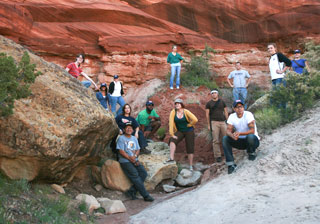 The Silversmiths made us a wonderful lunch of “Navajo Tacos,” which consists of the traditional Native American food of fry bread covered in taco food like beans, meat, lettuce and tomato, and we had homemade huckleberry jam on fry bread for dessert. Leland took us in to the capital of the reservation to allow us a chance to see Navajo history up close. We traveled in our van to Window Rock, AZ and got a chance to see the executive branch of the Navajo government. We were given a history of the tribe and an introduction to how the Navajo government works by the program manager, Lamont. We also heard what issues the Navajo people were still dealing with today.
The Silversmiths made us a wonderful lunch of “Navajo Tacos,” which consists of the traditional Native American food of fry bread covered in taco food like beans, meat, lettuce and tomato, and we had homemade huckleberry jam on fry bread for dessert. Leland took us in to the capital of the reservation to allow us a chance to see Navajo history up close. We traveled in our van to Window Rock, AZ and got a chance to see the executive branch of the Navajo government. We were given a history of the tribe and an introduction to how the Navajo government works by the program manager, Lamont. We also heard what issues the Navajo people were still dealing with today.
He told us of how Navajo men and women were approved to work in the uranium mines that the US government built on the reservation, but received no warnings about the harmful effects of radiation. Today, babies are born with deformities and the people who work in the mine are getting cancer. The educational system is nowhere near up to par with American public schools, though adequate education is one of the promises made by the treaty of 1864. These people must face constant encroachment on their land by outside forces, and Lamont offered that he believes it is because the Navajo people see the land that they live on as a small portion of land they have been able to retain, while the US government sees the land they live on as a generous portion of land they have allowed the Navajos to occupy. The mining industry on their land presents a deadly predicament. The mines are currently producing pollution that is poisoning the earth that the Navajos hold so sacred- it has contaminated the rivers and made them undrinkable, and harmed their people’s health. However, without the jobs and revenue generated by the mining industry, the Navajos would face even deeper poverty than they currently deal with. According to Lamont, recent statistics (since the recession) studying the Navajos show unemployment at around 55% and the average family income at a little over $8,000 annually per household.
But we heard hope in his stories, too. Lamont spoke of efforts to tailor their Head Start programs and grade school education to embrace the Navajo language that is quickly dying out as a result of previous generations, like George and Fanny, who were not allowed to speak it in their schools and so did not teach their children for fear they would be punished as well. He talked about forming culturally-sensitive educational models to teach a mixture of Western and Navajo history and culture, and how they are trying to instill in their children that if they leave the reservation for college, their Western education should complement their Navajo identity.
We also got a chance to visit the office of the largest Native-American-owned newspaper in the world, the Navajo Times. We learned lots of interesting information from the editor, who took time out of his day to show us around, but there was one point he made that really stuck with me because it was such a different mindset than others we had encountered on our journey. He told us how they, as a paper, refuse to capitalize on what he called “Navajo misery.” He said other papers in the area will cover tragic stories about the Navajos in a tabloid-like manner. However, the Navajo paper believes they have an ethical and cultural responsibility to their people to respect ceremony and mourning; if a tragedy has happened within a Navajo family, the Navajo Times reporters wait to be invited to the family’s home to cover the story and they do get invited because the community understands they will treat each life, each story, with respect. The editor told us “not everything is for sale.” However, comparing this mindset to Graceland, where millions are herded past the Presleys’ graves decorated with flags with Elvis music playing in the background, I realized that this ethical responsibility to treat each life with respect is not shared, that along the way we have continually found that almost everything is indeed for sale.
We left with Leland to return to his home, where we tried our hand at sheep-herding by driving out on his family’s land into a beautiful canyon where supposedly, we were going to find the sheep and herd them back to the pen in their backyard. We had a nice hike but eventually gave up on finding the sheep. Of course, when we returned to the house, the sheep were already back in the yard (so we decided we had done the job right anyway). We were all set to leave and give the Silversmiths a break from having guests, but Fanny, along with her daughter and granddaughter had already made us a second delicious meal. So we sat for the second time that day with this generous family, in their small frontyard overlooking some of the most beautiful land I’ve ever seen. Leland slipped easily into his traditional storytelling voice and told us a story about why it was important to protect our land today for the sake of our grandchildren. We eventually left this warm family setting with what seemed like a thousand hugs and a few tears as well.
We had asked them earlier in the day what it meant to be an American, as we have been asking people all along our journey. They all seemed to be confused by the question – Leland said they do not consider themselves American, they are Navajo. Their people have been here since before “America” even existed. In a way, you could view finding distinction between Navajos and Americans as a way that we are separate and different. But as Leland told us with sincerity over dinner, we are all the same – we are all people who deserve respect and who have a responsibility to our earth and our people. To hear this message from this family was touching and humbling. By the end of this trip, I hope I am even closer to living my life by the ideals that the Silversmiths live by. When we were driving back to our bus, Professor Spring asked for initial reactions about the day. The first thing we all expressed was the disbelief that we had never heard these stories about the history and current conditions of the Navajo people. How had we never learned about this important part of our own country? If we had never heard these stories, how many other Americans knew? So that is the goal of our posts from this day: to bring awareness about this group of people who feel (rightly so) forgotten by our country.
 I was going to write about hopelessness in Detroit.
I was going to write about hopelessness in Detroit.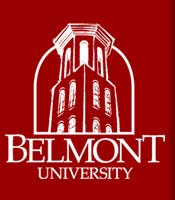
 Our day had an exciting start with a T.V. interview with the local news in Rapid City, South Dakota. Watch it at
Our day had an exciting start with a T.V. interview with the local news in Rapid City, South Dakota. Watch it at  Even though I’m from Medford, only 5.5 hours south of Portland, I haven’t spent much time in our state’s biggest city. Every athletic Oregonian kid goes up to Portland for at least one sports event: I’ve done my share of swimming and gymnastics meets there, too. But I’ve never really gone out and explored the city.
Even though I’m from Medford, only 5.5 hours south of Portland, I haven’t spent much time in our state’s biggest city. Every athletic Oregonian kid goes up to Portland for at least one sports event: I’ve done my share of swimming and gymnastics meets there, too. But I’ve never really gone out and explored the city. It is Friday morning in the Universe. I am sitting on a rock in the Redwood Forest about 30 feet from a small stream. The trees around me are easily one hundred feet tall and 6 to 10 feet wide. Today is our day to relax and reflect. I am not sure where to begin this post. I hope that those of you who have been following our blogs posts have gained a bit of insight into this excursion. Perhaps we have even inspired you to go out and explore our country.
It is Friday morning in the Universe. I am sitting on a rock in the Redwood Forest about 30 feet from a small stream. The trees around me are easily one hundred feet tall and 6 to 10 feet wide. Today is our day to relax and reflect. I am not sure where to begin this post. I hope that those of you who have been following our blogs posts have gained a bit of insight into this excursion. Perhaps we have even inspired you to go out and explore our country. So I was awoken at 3:00 this morning by Ken, telling me that the bus was breaking down and that we were going to have to turn back to Los Angeles to get it fixed. This was immediately followed by the words: “We might have to skip San Francisco all together.”! By 7:00 I was still trying to process what exactly was occurring and I started making phone calls informing the people whom we were supposed to meet with throughout the course of the day that we weren’t going to be in the city until at least 2:00 pm. However, given the stressful nature of the hours of re-planning, the morning was speckled with incredible music, conversations, card games and just an overall stillness of being awake without running off the bus in the usual fashion of this trip.
So I was awoken at 3:00 this morning by Ken, telling me that the bus was breaking down and that we were going to have to turn back to Los Angeles to get it fixed. This was immediately followed by the words: “We might have to skip San Francisco all together.”! By 7:00 I was still trying to process what exactly was occurring and I started making phone calls informing the people whom we were supposed to meet with throughout the course of the day that we weren’t going to be in the city until at least 2:00 pm. However, given the stressful nature of the hours of re-planning, the morning was speckled with incredible music, conversations, card games and just an overall stillness of being awake without running off the bus in the usual fashion of this trip.  We started out our first day in Los Angeles with a tour of CBS Studios in Studio City, CA, where they film shows like Entertainment Tonight and CSI: New York, while in the past other shows like Seinfeld and Gilligan’s Island. Entertainment Tonight’s Canaan Rubin showed us around many of the sets, studios, productions rooms, editing bays, and all the people that come together to make a show go on air.
We started out our first day in Los Angeles with a tour of CBS Studios in Studio City, CA, where they film shows like Entertainment Tonight and CSI: New York, while in the past other shows like Seinfeld and Gilligan’s Island. Entertainment Tonight’s Canaan Rubin showed us around many of the sets, studios, productions rooms, editing bays, and all the people that come together to make a show go on air.
 I decided to have Vegas be my first city because it is a place that I have already been to and I had fond memories of being there with my family. When the class got to scouting around the city though I realized that both the great, big city and I had changed. We both had grown and learned some stuff. No longer was I able to see this place simply as a tourist destination; instead I continued to find my vision of it clouded with all that I have gained thus far in my education.
I decided to have Vegas be my first city because it is a place that I have already been to and I had fond memories of being there with my family. When the class got to scouting around the city though I realized that both the great, big city and I had changed. We both had grown and learned some stuff. No longer was I able to see this place simply as a tourist destination; instead I continued to find my vision of it clouded with all that I have gained thus far in my education. Yesterday our bus was late heading into Salt Lake City, which was great because it put our group in the position to be able to see the city we were headed towards, rather than just magically wake up there. It was interesting to watch as we rolled into Salt Lake because we were literally in the middle of nowhere for the longest time, and then all of sudden the landscape of a city came into view. It didn’t appear to be too big or too small, but just the right size with tall buildings, an oil refinery and billboards waiting for us in the distance. Noticing that the mountains were situated around the city, it occurred to me that Salt Lake City is as unique as the grand body of water that it is named after.
Yesterday our bus was late heading into Salt Lake City, which was great because it put our group in the position to be able to see the city we were headed towards, rather than just magically wake up there. It was interesting to watch as we rolled into Salt Lake because we were literally in the middle of nowhere for the longest time, and then all of sudden the landscape of a city came into view. It didn’t appear to be too big or too small, but just the right size with tall buildings, an oil refinery and billboards waiting for us in the distance. Noticing that the mountains were situated around the city, it occurred to me that Salt Lake City is as unique as the grand body of water that it is named after.


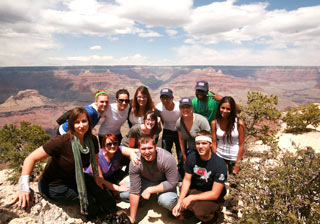
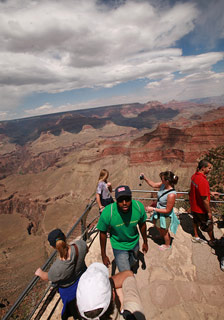
 Where to begin? I’m am completely overwhelmed by trying to convey in a few short paragraphs what this day meant to me personally, and how I think it affected our group as a whole. We had no idea what to expect from our day that would be spent on a portion of the Navajo Reservation of New Mexico and Arizona. We met up with our guide for the day, Leland Silversmith, at the reservation’s visitor’s center outside Gallup, NM and across the border into Arizona. For those who may not be familiar with the Navajos, I’ll attempt to give a very brief history of the land and people based on previous research that I, as the “ambassador” for this destination, had to undertake and information we were taught while on the reservation.
Where to begin? I’m am completely overwhelmed by trying to convey in a few short paragraphs what this day meant to me personally, and how I think it affected our group as a whole. We had no idea what to expect from our day that would be spent on a portion of the Navajo Reservation of New Mexico and Arizona. We met up with our guide for the day, Leland Silversmith, at the reservation’s visitor’s center outside Gallup, NM and across the border into Arizona. For those who may not be familiar with the Navajos, I’ll attempt to give a very brief history of the land and people based on previous research that I, as the “ambassador” for this destination, had to undertake and information we were taught while on the reservation.

 The Silversmiths made us a wonderful lunch of “Navajo Tacos,” which consists of the traditional Native American food of fry bread covered in taco food like beans, meat, lettuce and tomato, and we had homemade huckleberry jam on fry bread for dessert. Leland took us in to the capital of the reservation to allow us a chance to see Navajo history up close. We traveled in our van to Window Rock, AZ and got a chance to see the executive branch of the Navajo government. We were given a history of the tribe and an introduction to how the Navajo government works by the program manager, Lamont. We also heard what issues the Navajo people were still dealing with today.
The Silversmiths made us a wonderful lunch of “Navajo Tacos,” which consists of the traditional Native American food of fry bread covered in taco food like beans, meat, lettuce and tomato, and we had homemade huckleberry jam on fry bread for dessert. Leland took us in to the capital of the reservation to allow us a chance to see Navajo history up close. We traveled in our van to Window Rock, AZ and got a chance to see the executive branch of the Navajo government. We were given a history of the tribe and an introduction to how the Navajo government works by the program manager, Lamont. We also heard what issues the Navajo people were still dealing with today. When I was a kid, I used to look out my window up at the North Carolina sky every night. We lived 15 minutes from the airport, and the direct path to the main runway seemed to go right over our house.
When I was a kid, I used to look out my window up at the North Carolina sky every night. We lived 15 minutes from the airport, and the direct path to the main runway seemed to go right over our house. 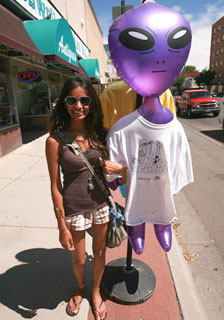
 Approaching El Paso, everyone in the group continued to think this day would give us a rest because it has a reputation as Podunk town. Eventually we would find this is far from the case in a border town. The scene of the area as we drove down the highway produced a visual distinction between Mexico and America as each landscape lied on either side of our van. Even though some areas from each country proved to be completely different with America’s vast developments and Mexico’s great poverty, other areas of the two countries looked frighteningly similar in poverty. This was the first among many aesthetics that point to the fact that El Paso seems to live up to its name which means “Crossing Over” as it proves separate from America and in fact a part of Juarez, Mexico.
Approaching El Paso, everyone in the group continued to think this day would give us a rest because it has a reputation as Podunk town. Eventually we would find this is far from the case in a border town. The scene of the area as we drove down the highway produced a visual distinction between Mexico and America as each landscape lied on either side of our van. Even though some areas from each country proved to be completely different with America’s vast developments and Mexico’s great poverty, other areas of the two countries looked frighteningly similar in poverty. This was the first among many aesthetics that point to the fact that El Paso seems to live up to its name which means “Crossing Over” as it proves separate from America and in fact a part of Juarez, Mexico.
